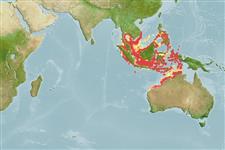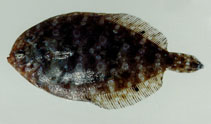Arnoglossus aspilos (Bleeker, 1851)
Spotless lefteye flounder
把你的觀察加入 Fish Watcher
| Native range | All suitable habitat | Point map | Year 2050 |

|
| This map was computer-generated and has not yet been reviewed. |
| Arnoglossus aspilos AquaMaps Data sources: GBIF OBIS |
上傳你的 相片 和 影像
Pictures | Google 影像Arnoglossus aspilos
Picture by Hermosa, Jr., G.V.
Pictures | Google 影像Arnoglossus aspilos
Picture by Hermosa, Jr., G.V.
分類 / Names 俗名 | 同種異名 | Catalog of Fishes(屬, 種) | ITIS | CoL | WoRMS | Cloffa
Teleostei > Pleuronectiformes (Flatfishes) 鰈形目 (Flatfishes) > Bothidae (Lefteye flounders) 鮃科 (Lefteye flounders)
Etymology: Arnoglossus: Greek, aros, -oy = lamb + Greek, glossa = tongue (Ref. 45335).
More on author: Bleeker.
Etymology: Arnoglossus: Greek, aros, -oy = lamb + Greek, glossa = tongue (Ref. 45335).
More on author: Bleeker.
Environment: milieu / climate zone / depth range / distribution range 生態學
分布 國家 | FAO區域 | 生態系 | 發現紀錄 | Point map | 簡介 | Faunafri
Indo-West Pacific: Persian Gulf to the coast of India; north to Taiwan through the South China Sea, south to Queensland. Specimens from northern and Western Australia often treated as distinct subspecies (Ref. 9824).
印度-西太平洋: 波斯灣到印度的海岸; 北至台灣經過南中國海, 南至昆士蘭省。 來自北部與西澳大利亞的標本時常視為了明顯的亞種。 (參考文獻 9824)
印度-西太平洋: 波斯灣到印度的海岸; 北至台灣經過南中國海, 南至昆士蘭省。 來自北部與西澳大利亞的標本時常視為了明顯的亞種。 (參考文獻 9824)
大小 / 重量 / 年齡
Maturity: Lm ? range ? - ? cm
Max length : 19.0 cm TL 雄魚/尚未辨別雌雄; (Ref. 9824); common length : 7.5 cm TL 雄魚/尚未辨別雌雄; (Ref. 9824)
Max length : 19.0 cm TL 雄魚/尚未辨別雌雄; (Ref. 9824); common length : 7.5 cm TL 雄魚/尚未辨別雌雄; (Ref. 9824)
簡短描述 檢索表 | 型態特徵 | 形態測量圖
背的軟條 (總數) : 80 - 84; 臀鰭軟條: 61 - 64.
Inhabits sand and mud bottoms (Ref. 9824). Feeds on bottom-living animals (Ref. 9824). Taken in shrimp trawls (Ref. 9824).
棲息於沙與泥底部。 (參考文獻 9824) 吃底棲動物。 (參考文獻 9824) 採自了蝦拖網。 (參考文獻 9824)
棲息於沙與泥底部。 (參考文獻 9824) 吃底棲動物。 (參考文獻 9824) 採自了蝦拖網。 (參考文獻 9824)
Life cycle and mating behavior 成熟度 | 繁殖 | 產卵場 | 卵 | 孕卵數 | 仔魚
印度-西太平洋: 波斯灣到印度的海岸; 北至台灣經過南中國海, 南至昆士蘭省。 來自北部與西澳大利亞的標本時常視為了明顯的亞種。 (參考文獻 9824)
主要參考資料
Upload your references | 參考文獻 | 合作者 : Amaoka, Kunio | 合作者
Kuronuma, K. and Y. Abe, 1986. Fishes of the Arabian Gulf. Kuwait Institute for Scientific Research, State of Kuwait, 356 p. (Ref. 5999)
CITES
Not Evaluated
對人類具威脅
無害處的
人類使用
漁業: 低經濟
FAO - Publication: search | FishSource |
更多資訊
Population dynamics
成長參數
Max. ages / sizes
Length-weight rel.
Length-length rel.
長度-頻率
Mass conversion
入添量
豐度
成長參數
Max. ages / sizes
Length-weight rel.
Length-length rel.
長度-頻率
Mass conversion
入添量
豐度
Life cycle
繁殖
成熟度
Maturity/Gills rel.
孕卵數
產卵場
Spawning aggregations
卵
卵發育
仔魚
稚魚動力學
繁殖
成熟度
Maturity/Gills rel.
孕卵數
產卵場
Spawning aggregations
卵
卵發育
仔魚
稚魚動力學
Anatomy
鰓區
Brain
Otolith
鰓區
Brain
Otolith
Physiology
Body composition
Nutrients
耗氧量
游泳類型
游泳速度
Visual pigments
Fish sound
Diseases & Parasites
Toxicity (LC50s)
Body composition
Nutrients
耗氧量
游泳類型
游泳速度
Visual pigments
Fish sound
Diseases & Parasites
Toxicity (LC50s)
Genetics
遺傳學
Heterozygosity
遺傳率
遺傳學
Heterozygosity
遺傳率
工具
E-book | 野外調查 | 檢索表 | 長度- 頻率 Wizard | 生活- 歷史的工具 | 分布圖 | Classification Tree
| Catch-MSY |
特別的報告
下載 XML
網路資源
AFORO (otoliths) | Aquatic Commons | BHL | Cloffa | BOLDSystems | Websites from users | 檢查 FishWatcher | CISTI | Catalog of Fishes: 屬, 種 | DiscoverLife | ECOTOX | FAO - Publication: search | Faunafri | Fishipedia | Fishtrace | GenBank: 基因組, 核甘 | GloBI | Google Books | Google Scholar | Google | IGFA World Record | MitoFish | 國家資料庫 | Otolith Atlas of Taiwan Fishes | PubMed | Reef Life Survey | Socotra Atlas | 樹狀分類階層 | Wikipedia: 去, 搜尋 | World Records Freshwater Fishing | 動物學的記錄
Estimates based on models
Preferred temperature (Ref. 123201): 26.2 - 28.6, mean 27.9 °C (based on 215 cells).
Phylogenetic diversity index (Ref. 82804): PD50 = 0.5000 [Uniqueness, from 0.5 = low to 2.0 = high].
Bayesian length-weight: a=0.00912 (0.00408 - 0.02036), b=3.04 (2.85 - 3.23), in cm total length, based on LWR estimates for this (Sub)family-body shape (Ref. 93245).
營養階層 (Ref. 69278): 3.5 ±0.37 se; based on food items.
回復力 (Ref. 120179): 中等的, 族群倍增時間最少 1.4 - 4.4年 (Preliminary K or Fecundity.).
Fishing Vulnerability (Ref. 59153): Low vulnerability (10 of 100).




